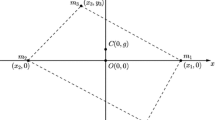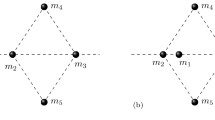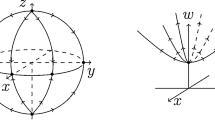Abstract
The Newtonian Four-Body Problem with positive and negative gravitational charges is studied from a physical point of view that considers inertial masses that are always positive and positive or negative charges in the gravitational interaction forces. The difference with respect to the differential equation of motion used in several mathematical papers is stressed. Formulation of the modified Dziobek equations is developed. We prove that four masses with one charge of different sign lead to a concave central configuration with the charge of different sign in the convex hull of the other three. For two charges of one sign and two charges of the opposite sign, we prove that the central configuration is convex with the two charges of the same sign on each diagonal. An algorithm used for computing the six distances between particles of a planar Four-Body central configuration, presented previously for positive gravitational masses, is adapted to compute physical central configurations with charges of different sign.
Similar content being viewed by others
References
Celli M.: The central configurations of four masses x, −x, y, −y. J. Differ. Equ. 235, 668–682 (2007)
Court N.A.: Notes on the orthocentric tetrahedra. Am. Math. Mon. 41, 499–502 (1934)
Dziobek O.: Über einer werkwürdingen Fall des Vielkörperproblems. Astr. Nachr. 152, 33–46 (1900)
Jose J.V., Saletan E.J.: Classical Mechanics, A Contemporary Approach. Cambridge University Press, Cambridge (1998)
Lehman-Filhés R.: Ueber swei Fälle des Vielkörpersproblems. Astr. Nachr. 127, 137–144 (1891)
Piña E., Lonngi P.: Central configurations for the planar Newtonian Four-Body Problem. Celest. Mech. Dyn. Astron. 108, 73–93 (2010)
Piña E.: New coordinates for the Four-Body Problem. Rev. Mex. Fis. 56, 195–203 (2010)
Piña, E.: Algorithm for planar 4-Body Problem central configurations with given masses. ArXiv 1006.2430 (2010)
Piña, E., Bengochea, A.: Hyperbolic geometry for the binary collision angles of the three-body problem in the plane. Qual. Theor. Dyn. Sys. 8, 399–417. Published online (09 february 2010) (2009)
Roberts G.E.: A continuum of relative equilibria in the five-body problem. Physica D 127, 141–145 (1999)
Shi J., Xie Z.: Classification of four-body central configurations with three equal masses. J. Math. Anal Appl. 363, 512–524 (2010)
Simó, C.: El conjunto de bifurcación en el problema espacial de tres cuerpos. In: Acta I Asamblea Nacional de Astronomí a y Astrofí sica. Instituto de Astrofí sica. (Univ. de la Laguna. Spain), pp. 211–217 (1975)
Simó C.: Relative equilibrium solutions in the four-body problem. Celest. Mech. Dyn. Astron. 18, 165–184 (1978)
Thornton S.T., Marion J.B.: Classical Dynamics of Particles and Systems, vol. 5th edn. Thomson Brooks/Cole, Mexico (2004)
Author information
Authors and Affiliations
Corresponding author
Rights and permissions
About this article
Cite this article
Piña, E., Lonngi, P. Central Configurations of Four Bodies with Gravitational Charges of Both Signs. Qual. Theory Dyn. Syst. 11, 215–229 (2012). https://doi.org/10.1007/s12346-011-0057-6
Received:
Accepted:
Published:
Issue Date:
DOI: https://doi.org/10.1007/s12346-011-0057-6




